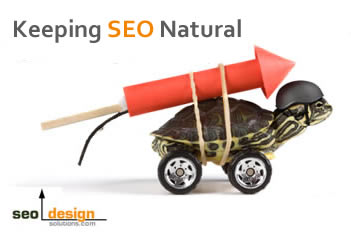It’s understandable why many feel the same way as the woman in the picture about organic SEO. You’ll need patience to see results and cultivating enough patience to reserve judgement is a true test of character; especially when money is on the line and your internal mental dialogue is more like a child on a long trip with the incessant mantra echoing – are we there yet?
In many ways, SEO is like planting seeds in a garden and waiting for the seeds to blossom into vibrant, self-sustaining plants (ROI generating keywords). There is a light at the end of the tunnel however, and today’s post discusses the relationship of time, rankings and return on investment.
The longer it takes to get ranked in search engines means the longer you are “out of pocket” on your SEO investment waiting for ROI to “put money back in the bank” to fuel another more lucrative or profitable keyword conquest. Affiliates know this more than anybody and business owners engaging an SEO campaign also need to be aware of this cycle.
To visualize this dilemma as a formula, it would look something like:
Money Invested/Time to Rank * Conversion Rate and Profit = ROI and budget to Reinvest in SEO.
While there are numerous considerations (such as keyword selection, competition and the current state of your website), the time to rank is impacted by competition and conversion, meaning, how many conversions were driven as a result of SEO and how long will it take to develop enough authority to crush your competition?
Aside from conversion, the time it takes to “get ranked” for keywords depends on numerous factors.
Considerations such as:
- Are you starting with a new domain?
- Is there existing/legacy content you can leverage for internal links?
- Do you have a friendly content management system or pliable coding platform that allows you to customize titles, url slugs, H1 tags, sidebar navigation, masthead and footers (on a page by page basis)?
- Are you implementing your website architecture properly to secure more competitive keywords?
- Are you deep linking to categories or specific landing pages or is your homepage eclipsing other pages and hording rankings?
- Do you have a content development plan to create supporting content and drip that content over time to (a) encourage increase search engine spider activity and (b) layered internal links?
- Are you limiting link loss on sidebars, using faceted navigation or server side includes to only pull relevant data into relevant categories?
- Are your templates optimal with the ability to personalize them based on if a page is a primary landing page, category page, product page, etc. instead of using the same old template with a one-size-fits-all content management or publishing platform that is not “SEO Friendly”.
- Are your pages providing the proper anchor text to other pages to create multiple strong pages in a website to make each category “self-sufficient” enough to pull its own weight in search engines?
- Are you scaling your website (with fresh content) or depending on leveraging existing pages?
Allow me to elaborate below…
Every of the metrics above help determine (a) how well you rank (b) how long it takes and (c) is your website strong enough to contend and defeat other competitors who have (1) achieved domain authority before you or (2) are already ranking in the top 3 for the keywords you want.
Are You Starting with a New Domain?
It is possible to get ranked quickly with a new domain; it just depends on the keywords you are targeting. There is a reason why you should target keywords within your reach so you can (a) target keywords with high demand, low competing pages and (b) you gain traction and trust to percolate your domain into a powerhouse if you cultivate it properly.It takes time to gain more authority, but as your pages get stronger, your domain gets stronger, and so the scope and species of keywords that your website can conquer also scales commensurately over time.
Is There Legacy Content to Leverage for Internal Links?
The fastest way to get ranked to get a link from a page that is already in the top 10 (for the keyword you seek, or a similar one). This tactics becomes incredibly viable when you realize that a link from within your own website is just as powerful as a link from another website (in fact even more important) if you have cultivated PageRank or ranking power to the page.
Do you Have a Pliable Content Management System?
Sometimes it’s better to start over from scratch if you have a lackluster content management system. This way you can collectively create the appropriate infrastructure, particularly if you are bound by variables that you cannot control.
Customizing your website templates, content and links is a holistic process that has its own ecosystem.
When the majority of the most critical ranking factors are aligned, you can skip what would have taken months (and in some instances) years to accomplish as a result of that convergence. While there are multiple systems to select from WordPress is easy to use, very effective and pliable, as well as Magento for ecommerce (which is packed with SEO features).
Are You Using Website Architecture to Support More Keywords?:
If you are not, it’s not too late to create tiered layers within a website and create content silos (nested layers of supporting articles) to push those tiers (landing pages) higher and higher till they reach the top 3 results.
Are you Deep Linking to Category Pages?
Are you deep linking to provide multiple pages that can rank or just using your homepage to consolidate rankings? You need links to internal pages (with anchor text that supports their primary 3 keywords) if you ever want to increase conversion and rank specific pages for specific keywords. Deep links implies linking to any other page other than the homepage of the site.If you implement facets of #4 and build the site based on a premise of tiers, any keyword is attainable with the proper amount of content, site architecture and links. You just need to know what the thresholds are for the keywords on the existing horizon.
Do You Have a Content Development Plan?
Websites do not just magically rank themselves; they need content and lots of it over time (to be competitive). While you may not need to scale to the level of Wikipedia, you still need to create authority for the topics your website is based on (if you ever wish to reach the top 5 results).This means you will need to create semantic nodes of relevance that overlap enough for search engines and humans to assess, interpret and create citation of the said content.
If you appeal to humans, they will link to you and / or visit your website (which creates authority) if you provide authoritative content, search engines with will score your pages and provide higher rankings. You cannot undermine quality, so if you haven’t already, get a content development strategy in place right now.
Are you Limiting Link-Loss on Sidebars?
Use faceted navigation or server side includes to pull theme relevant data into relevant categories. Template optimization is a critical step in advanced SEO. To simplify, creating pages with purpose and ensuring that they either reinforce the page they link to or the page itself creates buoyancy and rankings. For more on this topic, read this series on how to optimize templates for SEO.
Are your Templates Optimal?
Optimal meaning, do you have the ability to personalize each page (primary landing page, category page, product page) etc., without having to implement custom coding?
Your existing platform will determine your ability to craft new pages, modify older pages and whether or not the existing site segments will be a beacon or recede into the background as new proxy’s (new content management systems) or web platforms are utilized to migrate or create a hybrid between the legacy content and the new evolution/version of the new synthesized content.
Are You Providing the Proper Anchor Text Variation to Critical Pages?
If not, you are not creating multiple strong pages in your website. Managing link flow is important, you need to support pages with internal links based on the competitiveness of the keyword and the barrier to entry.
For important pages, you should have a minimum of 5 internal or inbound links to provide enough citation for that page to take on the attributes of what it was designated to rank for. For more about this tactic, read our post SEO rankings and how to create them.
Are you scaling your website with enough fresh content
Like anything the lasts, your website must grow and evolve. Keep this in mind when determining your content development strategy. Add fresh relevant content regularly and over time, your website will rank without links but from its own ability to have the web cater to it (as an authority) rather than having to chase keywords to get ranked.










Ohhhhh Thanks really for helpful article anyway !
How much time all SE Majorly Bing and Yahoo take to index while google already?
Thanks :) great tipps iam testing..
Hi lots of great ideas to look at here, I find with websites you have to be so careful because it seems that there are so many things that will hinder your progress to increasing your traffic. I guess hard work research and lots of testing is the best way to generate traffic.
great info and will start testing
Great info..!!
Thx for Your Info… Its A Great Info.. ^_^
Hi Iwan,
Just came across your article and I wanted to say thanks. Your information is clear and to the point.
I got it!
Half the time, SEO info is so round about that I just get more confused.
Thanks.
Patti McConville
Cranberry Corners Gift Baskets
Ottawa, Canada
Thanks for the great article…however, I am just starting out with my website, and most of the information here went over my head ( I hope I will be a lot better in 2-3 months)…
Can you please explain to me what “tiered layers within a website” means. I am using a wordpress website (for CMS). How can I know about its architecture? and understand which layers are Tier 1, which are the supporting layers etc.? Thanks
Tier 2 is category page, and tier 3 is supporting articles or product pages. For a better explanation of siloing, try this – https://seodesignsolutions.com/blog/seo-videos/seo-video-how-to-properly-silo-your-website/
Good information for new websites.
Tanks very much for thE tutorial. I think domaine âge also count.